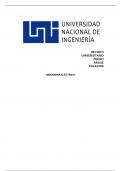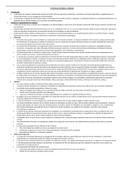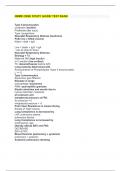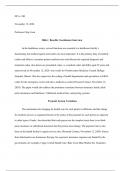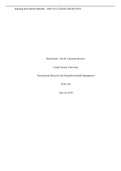Chapter 1: The Investment Environment
What is the difference between corporate finance and investment analysis?
• Corporate finance: mainly concerned with cash management, ensuring liquidity and raising funds,
how and where are we going to get money?
• Investment analysis: deals with the problems of investing funds, what do we do with the money
that we have?
Investments and financial assets
Why are financial markets interesting?
There may be situations where you earn more than you need for consumption, in that case you may
wish to shift part of your income to the future. Other times what you earn will be less than what you
need for consumption, in that case you might want to bring part of your future income to the
present.
The first problem can be solved by real assets, whereas financial assets can help in both situations…
• Real assets: assets that help to produce goods and services (real estate, machines, factories,
etc.)
• Financial assets: represent claims on real assets
Major classes of Financial Assets
1. Debt / Fixed income securities
• Money market instruments
• Bonds
Debt has a limited lifetime (with very few exceptions), you give away money for a couple of years
and you get a fixed interest rate every year as a return.
2. Stocks / Equity
• Common stocks
• Preferred stocks
Stocks/Equity has an unlimited lifetime and you don’t know in advance what you will receive, you get
what is left from the profit after taxes if the company decides to turn out a dividend, or nothing at all.
3. Derivative securities
4. Foreign currencies
The main subsets of asset classes in the investment universe are classical/traditional
investments and alternative investments…
1
, • TRADITIONAL INVESTMENTS
These are long term investments, you invest and wait/hope for success. You buy it now and
hope that in the future the price of it will increase, then you have a profit. Classical
investments include three asset classes:
Stocks (equity)
Bonds (or fixed income)
Cash (money market instruments, usually treasury bills)
• ALTERNATIVE INVESTMENTS
These cover a wide range of investments and use unconventional strategies and/or
unconventional investment vehicles. They include:
Hedge funds Commodities (e.g. gold)
Managed futures Private equity
Currencies Gems and stones
Derivatives Fine art, wine
*Managed futures: money managers who invest in derivatives, most of them are trend followers and react on
rising or falling markets. They go long and short.
In alternative investments there is a huge variation in terms of standardization, liquidity and
valuation.
Commodities, foreign currencies and derivatives are highly liquid and standardized, and their price can easily
be observed. Others, such as private equity and particularly collectibles are illiquid, unique and difficult to
price…
Liquidity may be very difficult in alternative investments, currencies is one of the most liquid markets,
but fine art is one of the most illiquid things… in classical investments liquidity is always high.
Fine art is also very heterogeneous, while this isn‘t the case for currencies for example. Both
heterogeneity and illiquidity increase if you go down in the list of alternative investments.
What all alternative investments have in common is that they
have a low correlation with traditional investments .
The pictures shows all the correlations with high
capitalisation stocks. The dark ones are classical
investements and the grey ones are alternative
investments.
Alternative investments are valuable because they give you a huge diversification benefit. They allow
us to diversify the risk because they have a low correlation with our existing investments (large
capitalisation stocks).
2
,Money market instruments
The money market is the market for short-term borrowing and lending. It is dominated by banks’
lending to each other.
Typical instruments:
• Treasury bills: short-term security issued by the U.S. government
• Commercial paper: securities issued by companies or banks
• Certificates or deposits
• Bankers acceptances
• …
Everything below one year to maturity is a money market instrument.
Treasury bills are often used as a proxy for the risk free rate of return. You know what you will get
back at the end with treasury bills, you buy at a discount and get more money back in the end then
what you paid for it. There is no risk because you know you‘ll have a profit.
Bond market: different issuers
Bond market = debt market = fixed income market: longer term securities than on the money market
Bonds can be issued by governement, by federal agencies, by companies…
• Plain vanilla bond: you know when you’ll get your money back, how much you will get back, what
interest rate will be used etc.
• Zero coupon bond: you pay something today and you get money at the end but no interest payments
in the meantime.
• …
The foreign exchange = FX
Why is the foreign exchange so important?
It affects inflation through the cost of imports, it affects national capital flows through risk and
returns of different assets. If the stock market keeps falling or raising for a long time, companies
might adjust the way the fund their activities. Therefore it is better for companies to buy different
assets from different countries to diversify their risk….
But the foreign exchange has a more direct impact through import and export and the risk for foreign
investments. The foreign exchange is a very important market.
Turnover ratio How often is every stock sold on the market?
3
, Chapter 2: Risk and return from the
historical record
Portfolio theory breaks investments down mainly to risk and return.
• Return: the amount of money gained or lost on an investment relative to the amount of
money invested.
Which factors do impact the interest rate?
• Supply of capital: by households
• Demand of capital: by businesses
• Government’s net supply and/or demand: actions by the ECB
C OMPARING RETURNS : ZERO COUPON BONDS
Assume that you have the choice between several zero-coupon bonds with different maturities and a
par value of 100. How can you compare them?
The return that you get is the holding period return over the period from t=0 to t=T.
It is a bit like an interest rate that you get throughout the period. The difference is that a normal
interest rate is fixed at the beginning.
PT P T −Pt
HPRt = –1=
Pt Pt
Pt = price today initial investment
PT = price at the end of the holding period final payout
HPRt = holding period return
BOND TIME TO MATURITY PRICE Pt HPRt
A 1 90 (100/90) – 1 = 0.11
B 5 80 (100/80) – 1 = 0.25
C 10 70 (100/70) – 1 = 0.43
The holding period returns increase for bond A to C. this does not necessarily mean that bond C is
better than the others. We can’t compare these bonds because they holding periods differ. The
holding period return is a good measure ONLY if the holding period is the same for all assets under
consideration. Otherwise we need to normalize the returns by the holding periods. You can do that
by calculating ‘one-year-equivalent-returns’.
4


